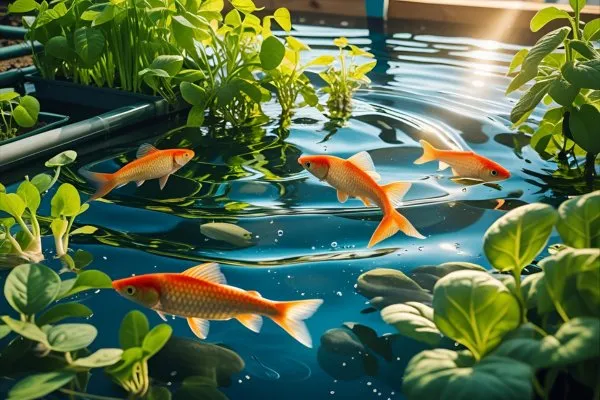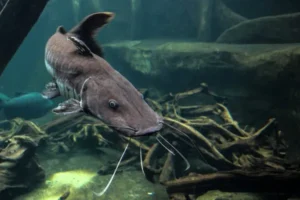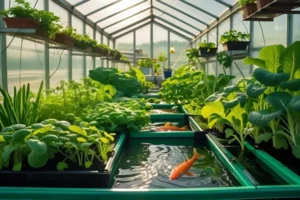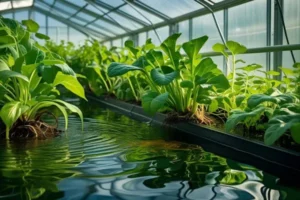Why Water Quality Makes or Breaks Your Aquaponics System
Aquaponics Water quality is the invisible foundation that determines whether your aquaponics system thrives or fails catastrophically. Unlike traditional gardening where soil acts as a buffer, aquaponics relies entirely on water chemistry to sustain both fish and plant life simultaneously.
Consider this stark reality: a single ammonia spike can kill an entire fish population within 24-48 hours, while poor pH balance can render nutrients completely unavailable to plants, causing them to starve despite abundant fertilizer. These aren’t theoretical risks—they’re daily realities that destroy thousands of aquaponics systems worldwide.
The interconnected nature of aquaponics makes water quality management both critical and complex. Fish waste becomes plant food through bacterial conversion, but this delicate biological process requires precise water conditions. When parameters drift outside optimal ranges, the entire nitrogen cycle collapses.
Successful aquaponics farmers understand that monitoring water quality isn’t just maintenance—it’s the difference between harvesting 30 pounds of fresh vegetables monthly versus watching your investment turn into an expensive disaster. Professional commercial operations test water parameters multiple times daily because they know that prevention costs pennies compared to system recovery.
Master water quality, and you’ll join the ranks of aquaponics growers achieving 10x faster plant growth than traditional gardening.
The 7 Critical Water Quality Parameters Every Aquaponics Grower Must Monitor
Understanding and managing seven critical water quality parameters separates successful aquaponics operations from failed experiments. These parameters work synergistically—when one falls out of range, others quickly follow, creating cascading system failures.
pH Levels (6.8-7.2) serve as the master controller, affecting nutrient availability and bacterial efficiency. Even 0.5-point deviations can reduce plant nutrient uptake by 50% or stress fish significantly.
Ammonia (0-0.25 ppm) represents the most immediate threat to fish health. Concentrations above 0.5 ppm become toxic, while levels exceeding 1.0 ppm prove lethal within hours.
Nitrite (0-0.25 ppm) indicates system cycling status and bacterial conversion efficiency. Elevated nitrite levels signal incomplete nitrogen processing, creating a bottleneck that stresses both fish and plants.
Nitrate (5-150 ppm) functions as plant fertilizer but requires careful balance. Too little starves plants, while excessive levels (200+ ppm) can inhibit plant growth and indicate poor system design.
Dissolved Oxygen (5+ mg/L) ensures fish respiratory health and bacterial activity. Levels below 4 mg/L stress fish, while concentrations under 3 mg/L prove fatal.
Temperature varies by species but typically ranges 68-78°F (20-26°C) for optimal fish health and bacterial activity. Fluctuations beyond 5°F (3°C) daily stress fish significantly.
Electrical Conductivity (0.5-2.0 mS/cm) measures total dissolved minerals, indicating nutrient concentration and system balance.
Professional aquaponics operations monitor these parameters using digital meters, maintaining detailed logs to identify trends before problems develop. Home growers often use combination test kits, checking critical parameters daily during system establishment and weekly once stabilized.
Essential Water Testing Tools and Equipment
Selecting appropriate testing equipment determines your ability to maintain optimal water quality and respond quickly to parameter changes. The choice between digital instruments and test strips often depends on budget, accuracy requirements, and testing frequency.
Digital vs. Strip Tests
Digital meters provide superior accuracy and long-term cost-effectiveness despite higher initial investment. Quality pH meters maintain ±0.1 accuracy compared to test strips’ ±0.5 variation. For commercial operations testing multiple times daily, digital equipment pays for itself within 3-6 months through reduced reagent costs.
Test strips offer convenience and lower upfront costs, typically ranging 15-25 USD for 50-100 tests. However, they’re susceptible to humidity degradation and provide less precise readings. Many beginners start with strips before upgrading to digital equipment as their systems expand.
Must-Have Testing Kits for Beginners
New aquaponics growers should prioritize a combination pH/TDS meter (80-120 USD), ammonia test kit (15-20 USD), and nitrite/nitrate testing strips (20-25 USD). This basic setup covers the most critical parameters without overwhelming beginners or straining budgets.
API Master Test Kit remains the industry standard for comprehensive water testing, providing 800+ tests for approximately 35 USD. It includes pH, ammonia, nitrite, and nitrate testing with reliable accuracy suitable for system establishment and troubleshooting.
Professional-Grade Equipment for Advanced Users
Serious aquaponics practitioners invest in calibrated digital meters for each parameter. Professional-grade pH meters (200-400 USD) feature automatic temperature compensation and replaceable probes. Dissolved oxygen meters (300-500 USD) provide real-time monitoring capabilities essential for high-density fish operations.
Multi-parameter meters combining pH, conductivity, dissolved oxygen, and temperature offer convenience for large-scale operations, typically costing 800-1500 USD. These instruments reduce testing time from 30 minutes to 5 minutes while providing laboratory-grade accuracy.
Consider probe replacement costs when budgeting—pH probes require annual replacement (50-80 USD), while dissolved oxygen probes last 12-18 months (80-120 USD) with proper maintenance.
Daily, Weekly, and Monthly Water Quality Monitoring Schedule
Establishing a systematic monitoring schedule prevents costly fish losses and plant failures while optimizing system performance. Frequency requirements vary based on system maturity, fish density, and operational scale.
Daily Checks: What to Monitor Every Day
During the first 8 weeks of system operation, test pH, ammonia, and nitrite daily. New systems experience volatile parameter swings as beneficial bacteria establish populations. pH fluctuations of 0.5-1.0 points are common, while ammonia and nitrite can spike unexpectedly during bacterial cycling.
Established systems require daily pH and temperature monitoring, taking 2-3 minutes with digital meters. Visual fish health checks complement testing—observe feeding behavior, gill movement rate, and activity levels. Lethargic fish or reduced appetite often signal water quality deterioration before test results confirm problems.
Commercial operations with high fish densities test ammonia and dissolved oxygen twice daily, typically morning and evening. Dense stocking rates (1 pound fish per 5-7 gallons) create rapid water quality changes that demand constant vigilance.
Weekly Deep Dive: Comprehensive Testing
Weekly testing should include nitrate levels, electrical conductivity, and comprehensive fish health assessment. Nitrate accumulation indicates system nutrient balance—levels below 10 ppm suggest insufficient fish waste for plant nutrition, while concentrations exceeding 200 ppm indicate poor plant uptake or system design flaws.
Document weekly results in testing logs, noting feeding amounts, weather changes, and system modifications. Pattern recognition enables proactive management rather than reactive crisis response.
Monthly System Health Assessment
Monthly deep assessments include water change volume calculations, bacterial health evaluation, and equipment calibration. Most aquaponics systems benefit from 10-20 percent monthly water changes to remove accumulated minerals and organic compounds.
Calibrate digital meters monthly using standard buffer solutions—pH 7.0 and pH 4.0 buffers cost approximately 15 USD and ensure continued accuracy. Replace probe storage solutions and clean electrode surfaces to maintain reliable readings throughout the testing cycle.
How to Correct Common Water Quality Problems
Rapid response to water quality issues prevents system catastrophes and minimizes fish mortality. Understanding correction methods and their timeframes enables confident problem resolution without panic-driven overcorrection.
pH Too High or Too Low: Natural Solutions
High pH (above 7.5) responds well to gradual organic acid addition. Add 1-2 tablespoons of white vinegar per 100 gallons, testing every 2 hours until reaching 6.8-7.2 range. Never adjust pH more than 0.5 points daily—rapid changes shock fish more severely than slightly off-range conditions.
Low pH (below 6.5) typically indicates insufficient buffering capacity. Add 1 teaspoon of potassium bicarbonate per 100 gallons, dissolving completely before system addition. Commercial pH buffers cost 20-30 USD and provide more stable long-term correction than household chemicals.
Ammonia Spikes: Emergency Response
Ammonia levels above 0.5 ppm require immediate action. Reduce feeding by 50-75 percent until levels stabilize below 0.25 ppm. Add beneficial bacteria supplements (15-25 USD) to accelerate biological filtration establishment.
For emergency situations exceeding 1.0 ppm, perform 25-50 percent water changes using dechlorinated water. Increase aeration temporarily to support stressed fish respiratory systems.
Low Dissolved Oxygen: Aeration Strategies
Dissolved oxygen below 5 mg/L indicates inadequate system aeration. Add air stones or increase air pump capacity—each horsepower of air pump supports approximately 1000 gallons in warm conditions. Venturi valves provide cost-effective oxygenation for 30-50 USD installation cost.
Reduce fish feeding during low oxygen events since digestion consumes additional oxygen. Cool water holds more dissolved oxygen, so shade systems during extreme heat periods.
Temperature Fluctuations: Climate Control
Temperature swings exceeding 5°F daily stress fish significantly. Insulate fish tanks using foam board (10-15 USD per sheet) or install aquarium heaters for cold climates. Chilling systems for hot climates cost 200-500 USD but prove essential for summer operation in southern regions.
Seasonal Water Quality Management
Seasonal temperature and daylight changes significantly impact aquaponics water chemistry, requiring proactive management strategies to maintain system stability throughout the year.
Spring System Startup
Spring reactivation demands careful temperature monitoring as beneficial bacteria populations rebuild after winter dormancy. Gradually increase feeding rates over 2-3 weeks, starting with 25 percent normal amounts. Cold water below 50°F (10°C) severely reduces bacterial activity, causing ammonia accumulation despite established biofilter media.
Monitor pH closely during spring startup—melting snow and increased rainfall can dilute system buffers, causing pH crashes. Test daily for the first month, maintaining spare potassium bicarbonate reserves for quick pH correction.
Summer Heat Management
High temperatures above 85°F (29°C) stress most aquaponics fish while reducing dissolved oxygen levels significantly. Water at 80°F holds 25 percent less oxygen than 70°F water, requiring increased aeration capacity during heat waves.
Implement shade cloth (70-80 percent density, 50-100 USD) over fish tanks and plant growing areas. Evaporative cooling systems reduce water temperature 5-10°F through strategic fan placement and water circulation. Monitor pH more frequently since evaporation concentrates minerals and raises alkalinity.
Fall Preparation
Decreasing daylight triggers fish metabolism slowdown, requiring feeding reduction to prevent water quality deterioration. Reduce feeding by 25-50 percent as water temperatures drop below 65°F (18°C).
Harvest excess plant biomass before decomposition begins—rotting vegetation consumes oxygen and releases ammonia. Clean debris from pipes and filters to prevent winter ice blockages in cold climate installations.
Winter Maintenance
Cold weather operations require heater installation (100-300 USD depending on tank size) and insulation upgrades. Maintain minimum 55°F (13°C) for continued bacterial activity and fish survival.
Reduce testing frequency to twice weekly in stable winter systems, but increase ammonia monitoring if heater malfunctions occur. Ice formation blocks aeration systems, so install de-icers or heated air stones in outdoor installations to maintain critical oxygen levels throughout winter months.
Natural Methods to Improve Water Quality
Sustainable aquaponics systems rely on biological processes and natural balance rather than chemical interventions to maintain optimal water quality. These methods create self-regulating environments that reduce maintenance requirements while improving system resilience.
Beneficial Bacteria Boosting
Establishing robust bacterial colonies accelerates nitrogen processing and stabilizes water chemistry. Introduce diverse bacterial strains through aged aquarium gravel, compost tea, or commercial bacterial supplements costing 15-25 USD. Avoid antibacterial soaps near systems—residual chemicals eliminate beneficial bacteria populations within hours.
Create bacterial habitat using lava rock, expanded clay pebbles, or bio-balls in dedicated biofilter chambers. Surface area determines bacterial capacity—each cubic foot of porous media supports approximately 50-75 gallons of fish tank capacity. Maintain consistent water flow through bacterial media to prevent anaerobic dead zones that produce toxic hydrogen sulfide.
Plant-Based Filtration
Strategic plant selection enhances natural filtration while producing valuable crops. Fast-growing plants like watercress, mint, and lettuce consume nitrates rapidly, preventing accumulation. Floating plants such as water hyacinth and water lettuce excel at nutrient uptake but require regular harvesting to prevent system takeover.
Root zone bacteria in plant beds provide secondary biological filtration, processing nutrients missed by primary biofilters. Deep water culture systems benefit from adding 10-20 percent floating plants to supplement mechanical filtration systems.
Biological Balance Techniques
Maintain fish-to-plant ratios of 1 pound fish per 5-8 square feet of growing space for optimal nutrient cycling. Overstocking creates excess waste, while understocking starves plants of essential nutrients.
Introduce beneficial insects and microorganisms through organic compost additions—1 tablespoon per 100 gallons monthly. These organisms break down organic matter and compete with harmful bacteria for resources.
Establish refugium areas using native aquatic plants that provide fish habitat while processing nutrients. These biological buffers absorb parameter fluctuations and create ecosystem stability that chemical treatments cannot replicate, resulting in more resilient long-term system performance.
When to Perform Water Changes in Aquaponics
Water changes in aquaponics differ fundamentally from traditional aquarium management. While aquariums rely on frequent water changes for waste removal, aquaponics systems convert waste into plant nutrients, making excessive water changes counterproductive and costly.
Frequency Guidelines
Established aquaponics systems typically require only 10-20 percent monthly water changes compared to weekly 25-50 percent changes in fish-only tanks. Mature systems with balanced fish-to-plant ratios often operate 3-6 months between significant water changes, relying on evaporation replacement and minor top-offs.
New systems during the first 8 weeks may require weekly 15-25 percent changes to manage cycling fluctuations. Monitor nitrate accumulation—levels consistently above 150 ppm indicate insufficient plant uptake and necessitate water changes to prevent nutrient lockout.
Calculate replacement costs before implementing change schedules. Municipal water averaging 0.005 USD per gallon means a 20 percent change in a 1000-gallon system costs 10 USD plus dechlorination chemicals. Annual water change expenses can reach 120-200 USD for medium-scale operations.
Emergency Water Change Situations
Immediate water changes become necessary when ammonia exceeds 1.0 ppm, pH drops below 6.0 or rises above 8.0, or fish show severe distress symptoms. Emergency changes of 25-50 percent using aged, dechlorinated water can save fish populations during system crashes.
Medication treatments often require water changes post-treatment to remove pharmaceutical residues harmful to beneficial bacteria. Salt treatments exceeding 0.3 percent concentration need dilution through partial water changes before reintroducing sensitive plant species.
Volume Recommendations
Standard maintenance changes should not exceed 25 percent system volume to preserve bacterial populations and system stability. Larger volumes shock both fish and beneficial bacteria, potentially triggering secondary cycling events that destabilize nitrogen processing.
Pre-age replacement water 24-48 hours with aeration to remove chlorine and balance temperature. Well water users should test for high mineral content—iron levels above 0.3 ppm or hardness exceeding 300 ppm may require treatment before system addition to prevent plant nutrient deficiencies.
Warning Signs: Recognizing Water Quality Issues Early
Early detection of water quality problems prevents costly fish losses and system crashes. Experienced aquaponics practitioners recognize subtle behavioral and visual cues that precede measurable parameter changes by 12-24 hours.
Fish Behavior Changes
Healthy fish exhibit consistent feeding patterns, active swimming, and regular gill movement. The first warning sign appears as reduced appetite—fish refusing food within 30 seconds typically indicates rising ammonia or dropping dissolved oxygen levels before test kits detect changes.
Gasping at the water surface suggests dissolved oxygen below 4 mg/L, while lethargy and bottom-sitting behavior often precedes ammonia spikes. Fish clustering near water inlets or air stones indicates oxygen stress, requiring immediate aeration increases.
Color changes provide additional early warnings—pale or darkening fish colors suggest pH fluctuations or ammonia stress. Torn fins, red streaking, or excessive mucus production indicate deteriorating water conditions requiring immediate testing and correction.
Plant Stress Indicators
Plant health reflects long-term water quality trends more reliably than short-term fish behavior. Yellowing leaves typically indicate nitrogen deficiency from inadequate fish waste or excessive water changes that remove nutrients before plant uptake.
Stunted growth despite adequate lighting suggests pH problems preventing nutrient absorption. Brown leaf edges indicate potassium deficiency or salt accumulation from excessive evaporation without water changes.
Algae blooms signal imbalanced nutrients—excessive phosphorus from overfeeding combined with inadequate plant competition. Green water conditions reduce dissolved oxygen at night, creating secondary fish stress.
System Performance Red Flags
Unusual odors provide immediate system health indicators. Healthy aquaponics systems smell earthy and clean, while sulfur odors indicate anaerobic bacterial activity from poor water circulation or dead zones.
Cloudy water suggests bacterial blooms from overfeeding or inadequate biological filtration. Foam accumulation indicates high protein levels from decomposing organic matter or excessive fish waste production.
Monitor pump performance daily—reduced flow rates from clogged filters or failing pumps create cascading water quality problems within hours. Backup pump systems costing 150-300 USD prevent total system failure during equipment malfunctions, protecting months of biological development investment.
Conclusion and Quick Reference Checklist
Mastering water quality management transforms aquaponics from a challenging experiment into a productive, sustainable food production system. Consistent monitoring, proactive management, and understanding seasonal variations ensure long-term success while minimizing fish losses and plant failures.
Successful aquaponics practitioners develop systematic approaches that balance testing frequency with practical time constraints. Beginning with daily testing during system establishment, then transitioning to weekly monitoring for mature systems, creates the foundation for sustainable operations.
Investment in quality testing equipment pays dividends through improved system stability and reduced emergency interventions. A basic testing setup costing 150-200 USD prevents thousands in fish and plant losses while building confidence in system management.
Quick Reference Checklist
Daily (New Systems):
- pH level: 6.8-7.2
- Temperature: Species-appropriate range
- Fish behavior and feeding response
- Visual system inspection
Weekly (Established Systems):
- Ammonia: 0-0.25 ppm
- Nitrite: 0-0.25 ppm
- Nitrate: 10-150 ppm
- Dissolved oxygen: Above 5 mg/L
Monthly:
- Equipment calibration
- Deep system cleaning
- Water change evaluation
- Growth rate assessment
Emergency Actions:
- Ammonia above 0.5 ppm: Reduce feeding, increase aeration
- pH outside 6.5-7.5: Gradual adjustment with buffers
- Low oxygen: Additional aeration, reduce feeding
- Fish distress: Immediate water testing and correction
Remember: prevention through consistent monitoring costs significantly less than emergency corrections. Your aquaponics system’s success depends on the foundation of excellent water quality management.
Ready to implement these water quality strategies in your aquaponics system? Start with basic testing equipment and develop your monitoring routine today!
Frequently Asked Questions (FAQ)
How often should I test water quality in a new aquaponics system?
Test daily for the first 8 weeks, focusing on pH, ammonia, and nitrite. New systems experience volatile parameter swings as beneficial bacteria establish. Once cycling completes and readings stabilize, transition to weekly testing for established systems.
What’s the minimum budget needed for water testing equipment?
A basic testing setup costs 150-200 USD, including pH meter, ammonia test kit, nitrite/nitrate tests, and dissolved oxygen strips. Digital meters require annual calibration solutions costing 15-20 USD but provide faster, more accurate results than liquid test kits.
Can I use pool test strips for aquaponics water testing?
Pool strips measure chlorine and basic pH but lack sensitivity for critical aquaponics parameters like ammonia and nitrite. Aquarium-specific test kits provide necessary accuracy for detecting dangerous levels that pool strips miss entirely.
Why does my pH keep dropping in my aquaponics system?
pH naturally decreases as beneficial bacteria convert ammonia to nitrate, producing acid as a byproduct. Add potassium bicarbonate (1 teaspoon per 100 gallons) to restore buffering capacity. Crushed coral or limestone in biofilters provides long-term pH stability.
How long can fish survive poor water quality conditions?
Fish tolerance varies by species and parameter severity. Ammonia above 1.0 ppm can kill fish within 24-48 hours, while gradually declining oxygen levels provide 6-12 hours before mortality begins. Emergency aeration and immediate water changes prevent losses during critical situations.
Do I need expensive monitoring equipment for small home systems?
Small systems under 200 gallons function successfully with basic test kits costing 50-75 USD. However, digital pH meters improve accuracy and save time for any system size. Automated monitoring systems become cost-effective for operations exceeding 500 gallons or commercial installations.
What’s the most critical parameter to monitor daily?
pH affects all other water chemistry aspects and changes rapidly. Daily pH monitoring prevents cascading problems that compromise fish health and plant nutrient uptake throughout the entire system.



